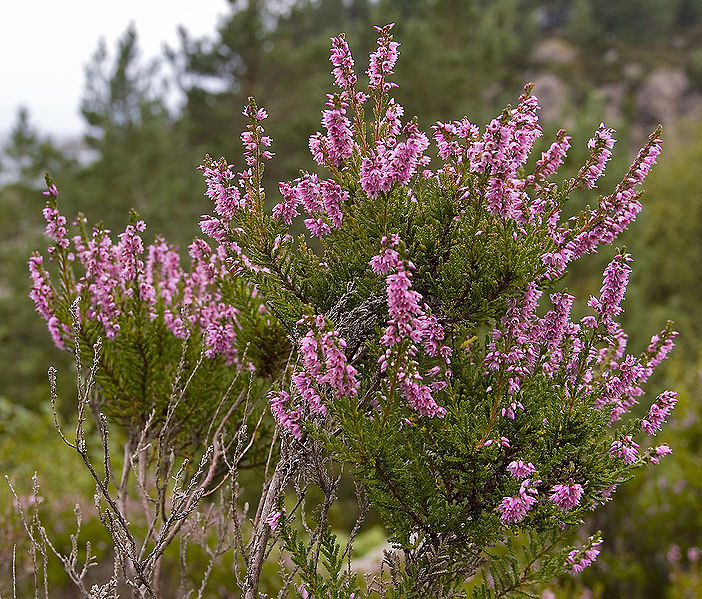Latin Name: Hedera helix
Common Name: English ivy
Family: Araliaceae
Origin: Europe, Western Asia
Tree/Shrub/Herb: Evergreen liana
Form: Low, mat-like
Habit: Spreading
Buds: Alternate
Leaves: Reproductive leaves chordate, vegetative leaves lobed and palmate
Flowers: Yellow umbels
Fruit: Blue berries
Stem/Bark: Light brown
Cultural Requirements: Medium, moist, well drained soil; full sun to partial shade
Landscape Uses: None. This plant should never be used.
Notes: This plant is too weedy/invasive to ever be used.
Latin Name: Iberis sempervirens
Common Name: candy tuft
Family: Brassicaceae
Origin: Southern Europe
Tree/Shrub/Herb: Evergreen sub-shrub
Form: Low groundcover
Habit: Spreading
Buds: Alternate
Leaves: Linear leaves whorled around stem
Flowers: White, 4 petals, flowers in April
Cultural Requirements: Prefers alkaline soils, likes dry soils, full sun, OK in part shade
Landscape Uses: Groundcover, best planted in drifts
Notes: 12-16in high
Latin Name: Juniperus horizontalis
Common Name: horizontal/creeping juniper
Family: Cupressaceae
Origin: Northern North America
Tree/Shrub/Herb: Coniferous shrub
Form: Generally rounded
Habit: Ascending, spreading branches
Leaves: Scaly leaves
Fruit: Fleshy arils
Stem/Bark: Brown with striations
Cultural Requirements: Doesn't tolerate wet soil, prefers poor soil and full sun
Landscape Uses: For larger garden spaces, contrast to leafy plants
Notes: Susceptible to juniper twig blight, a fungal disease affecting top growth
Latin Name: Calluna vulgaris
Common Name: heather
Family: Ericaceae
Origin: Europe and Asia Minor
Tree/Shrub/Herb: Evergreen sub-shrub
Form: Low groundcover
Habit: Matlike
Buds: Opposite
Leaves: Scale-like leaves
Flowers: Urn shaped flowers, blooms late summer to early winter
Stem/Bark: Woody, grey/brown
Cultural Requirements: Prefers acidic, poor soil
Landscape Uses: Groundcover, colour
Notes: Root balls need to be watered before planting
Latin Name: Erica carnea
Common Name: heath
Family: Ericaceae
Origin: Mountains of Central and Southern Europe
Tree/Shrub/Herb: Evergreen sub-shrub
Form: Low groundcover
Habit: Matlike
Buds: Whorled
Leaves: Needles
Flowers: Fused corolla, white to pink-red, blooms December to May
Stem/Bark: Woody, brown/grey
Cultural Requirements:Moist, acidic, well drained soil; full sun to partial shade
Landscape Uses: Groundcover, colour
Notes: Identified from Calluna vulgaris by having needles rather than scales
Latin Name: Syringa meyeri
Common Name: Meyer's lilac
Family: Oleaceae
Origin: Northern China, Japan
Tree/Shrub/Herb: Deciduous shrub
Form: Upright, rounded
Habit: Multi-stemmed from base
Buds: Opposite, large ovoid terminal buds
Leaves: Smaller leaves than Syringa vulgaris
Flowers: Pannicles of purple florets
Stem/Bark: Greyish-brown bark, textured, roundish white lenticels
Cultural Requirements: Drought tolerant
Landscape Uses: Colour, large centerpiece shrub
Notes: 4 to 8 feet tall
Latin Name: Picea abies
Common Name: Norway spruce
Family: Pinaceae
Origin: Northern Europe
Tree/Shrub/Herb: Coniferous tree
Form: Upright, conical
Habit: Upward sweeping primary branches
Leaves: Needle-like, square, dark green
Fruit: Long pendulous cones, 9-17cm long
Stem/Bark: Brown with striations
Cultural Requirements: Well drained, sandy, acidic soil
Landscape Uses: Park tree, large garden tree
Notes: Dwarf cultivars are available
Latin Name: Pinus mugo
Common Name: mugo pine
Family: Pinaceae
Origin: Mountainous Central Europe
Tree/Shrub/Herb: Coniferous tree
Form: Rounded when pruned or upright when open grown
Habit: Pruned to mound shape or open grown and arborescent
Leaves: Needles in fascicles of 2, up to 2 inches long
Fruit: 1-2 inch long cones
Stem/Bark: Brown with striations
Cultural Requirements: Prefers deep and well drained soil, but is quite hardy
Landscape Uses: Most often used as pruned mounds in public spaces or personal gardens
Notes: It is rare to see a large open grown specimen
Latin Name: Cotoneaster dammeri
Common Name: cotoneaster
Family: Rosaceae
Origin: Central and Southern China
Tree/Shrub/Herb: Evergreen sub-shrub
Form: Low, matlike
Habit: Spreading
Buds: Alternate
Leaves: Ovate, glabrous, rounded tip
Flowers: White flowers, 5 petals
Fruit: Red drupes
Stem/Bark: Brown, woody
Cultural Requirements: Well drained organic soil, full sun to partial shade
Landscape Uses: Ground-cover, often used in industrial settings
Notes: Much hardier than Arctostaphalos so is a better option for high traffic areas
Latin Name: Lithodora diffusa
Common Name: lithodora
Family: Boraginaceae
Origin: Garden origin, europe
Tree/Shrub/Herb: Evergreen sub-shrub
Form: Low, matlike
Habit: Spreading
Buds: Alternate
Leaves: Leaves whorled around stem, lanceolate, pubescent
Flowers: Small blue flowers, 5 petals, blooms late summer into fall
Cultural Requirements: Prefers alkaline soils, dry, well drained soil
Landscape Uses: Groundcover
Notes: Will often grow shabby
Latin Name: Osmanthus heterophyllus 'Variegatus'
Common Name: false holly
Family: Oleaceae
Origin: East Asia
Tree/Shrub/Herb: Evergreen shrub
Form: Upright, rounded
Habit: Upward arching branches
Buds: Opposite
Leaves: Spiny holly-like leaves, but not as thick or lustrous as holly
Flowers: White, fragrant, four lobed corolla
Stem/Bark: Brown, platy
Cultural Requirements: Draught tolerant, average soil, full sun to part shade
Landscape Uses: Large shrub with nice foliage for a larger space in a home garden
Notes: Very fragrant in late fall
Latin Name: Sorbus 'Joseph Rock'
Common Name: Joseph Rock
Family: Rosaceae
Origin: Garden origin, parents from China
Tree/Shrub/Herb: Deciduous tree
Form: Upright, arbourescent
Habit: Single main trunk, upwards pointing branches
Buds: Alternate, reddish, pointed, imbricate scales
Leaves: Odd pinnately compound
Flowers: Corymb
Fruit: Yellow berries
Cultural Requirements: Needs moisture and drainage
Landscape Uses: Garden or park tree
Notes: The only yellow berried Sorbus, root stock form European mountain ash
Latin Name: Meliosma pinnata
Common Name: worm head tree
Family: Sabiaceae
Origin: Maritime East Asia
Tree/Shrub/Herb: Deciduous tree
Form: Upright, arbourescent
Habit: Compact in sun, spreading in shade
Buds: Clustered arrangement, no bud scales, very distinctive look
Leaves: Pinnately compound, red glands at leaf margins, ovate, serrated margin
Flowers: Plume-like flowers produced after leaves, yellowish-white
Fruit: Red drupes
Cultural Requirements: Needs moisture and well drained soil
Landscape Uses: Is not yet a popular landscape plant, but has potential to be
Notes: Smells slightly of sour milk, will grow rapidly in a short time
Latin Name: Nandina domestica
Common Name: nandina, heavenly bamboo
Family: Berberidaceae
Origin: East Asia
Tree/Shrub/Herb: Evergreen shrub
Form: Upright, multi-stemmed
Habit: Pachycaulis (thick stemmed with few secondary branches)
Buds: Alternate
Leaves: Tri-tournately compound, leaflets ovate, acute apex, petiole clasps most of way around stem
Flowers: Pannicle of pinkish florets with 5 petals, flowers in spring
Fruit: Red drupes
Cultural Requirements: Hardy, well drained soil, full sun to part shade
Landscape Uses: Leaf texture in a home garden setting
Notes: Will grow to 5m tall if protected from cold
Latin Name: Brachyglottis 'Sunshine'
Common Name: daisy shrub
Family: Asteraceae
Origin: New Zealand
Tree/Shrub/Herb: Deciduous shrub
Form: Low groundcover
Habit: Mounded, spreading
Buds: Whorled
Leaves: Young leaves pubescent on both sides, old leaves pubescent on back only
Flowers: Yellow, daisy-like flowers
Stem/Bark: Woody stems
Cultural Requirements: Needs sun and good drainage
Landscape Uses: Groundcover, best used in larger drifts, greyish foliage provides contrast
Notes: Can grow to 1m tall
Latin Name: Actinidia deliciosa
Common Name: kiwi vine
Family: Actinidiaceae
Origin: China
Tree/Shrub/Herb: Deciduous liana
Form: Vine
Habit: Climbing
Buds: Alternate
Leaves: Large, roundish, red petioles
Flowers: 6 petals, yellowish, 6cm across, showy pistils and stamens on female flowers
Fruit: Hairy green-brown berries
Stem/Bark: Hairy red stems
Cultural Requirements: Good drainage, protection from cold
Landscape Uses: On an arbour or other supportive structure
Notes: Cats are attracted to the smell of the plant
Latin Name: Rosa x odorata 'Mutabilis'
Common Name: tea rose
Family: Rosaceae
Origin: Garden origin
Tree/Shrub/Herb: Semi-evergreen shrub
Form: Sprawling
Habit: Long, vigorous primary shoots
Buds: Alternate
Leaves: Pinnately compound, prominent stipules, serrated margin
Flowers: Flowers emerge pink/apricot then darken with age to deep red in 3-5 days
Fruit: Hips
Stem/Bark: Purle stems, prickly
Cultural Requirements: Full sun, organic soil, well drained
Landscape Uses: Garden shrub for moderately sized area, adds red colour
Notes: continues to flower throughout season until frost, resistant to black spot
Latin Name: Rubus rolfei 'Formosan Carpet'
Common Name: formosan carpet
Family: Rosaceae
Origin: Garden origin
Tree/Shrub/Herb: Evergreen shrub
Form: Low, matlike
Habit: Spreading, creeping
Buds: Basal
Leaves: Irregular margin, lobed, palmately veined, turn purple with extreme heat or cold
Flowers: White, solitary
Fruit: Aggregate fruit of druplets, orangey
Stem/Bark: Prickly stems
Cultural Requirements: Shade tolerant, acidic soil, hardy
Landscape Uses: Ground cover, erosion control
Notes: Underside of leaf is a very pale green/white compared to topside
Latin Name: Sorbus pseudohupehensis 'Pink Pagoda'
Common Name: pink pagoda
Family: Rosaceae
Origin: China
Tree/Shrub/Herb: Deciduous tree
Form: Upright, arbourescent
Habit: Single main trunk, upwards pointing branches
Buds: Alternate
Leaves: Toothed margin on terminal half of leaflets, odd pinnately compound, variation in leaf shape between leaves on reproductive and vegetative shoots
Flowers: White clusters
Fruit: Pink berries
Cultural Requirements: Needs moisture and good drainage
Landscape Uses: Good residential garden tree
Notes: A good tree for about 30 years before becoming infested with borers and declining
Latin Name: Arbutus unedo
Common Name: strawberry tree
Family: Ericaceae
Origin: Turkey to Spain
Tree/Shrub/Herb: Semi-evergreen shrub
Form: Upright, rounded
Habit: Horizontal primary branching
Buds: Alternate
Leaves: Serrated margin
Flowers: flowers from Oct. to Dec.
Fruit: Strawberry-like fruits take one year to ripen, thus plant has flowers and fruits simultaneously
Stem/Bark: Red bark, does not peel
Cultural Requirements: Needs drainage, hardier and less fickle than Arbutus Menziesii
Landscape Uses: Often found in public landscaping areas (shopping centres, etc...)
Notes: Can grow to 7m tall
Latin Name: Camellia sasanqua 'Setsugekka'
Common Name: yuletide camellia
Family: Theaceae
Origin: China and Japan
Tree/Shrub/Herb: Evergreen shrub
Form: Upright, rounded
Habit: Densely branched
Buds: Alternate
Leaves: Simple, glabrous, dark green, acute apex
Flowers: Showy white flowers, yellow stamens, flowers in November
Cultural Requirements: Draught tolerant, good drainage, partial sun
Landscape Uses: Showy shrub for the winter garden
Notes: Flower buds are formed the summer season before they flower


















No comments:
Post a Comment